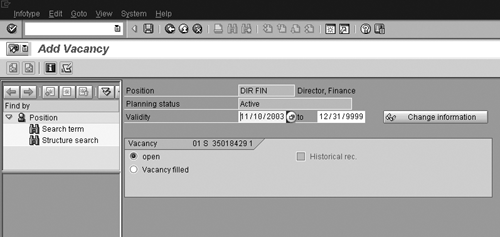The author explains that when you terminate an employee in R/3, the only thing the system does is delimit (put an end date on) the A 008 (holder) relationship between the person and the position. That is why the position object still exists after the employee has been terminated. She then discusses how to distinguish between a vacant position that will be filled from one that will not, and explains how to clean out positions that will not be filled.
Dear HR Expert,
At my company, we are running SAP HR Organizational Management (OM) 4.6C. We think it is difficult to handle the control of all positions. My concern is that we have a lot of open positions that are not really open. Let me give you an example. The production department hires 30 employees as temporary staff for a period of three months. We create 30 positions. After the three months, we terminate the 30 people and do not know if they are to be rehired later. This means that we first run the termination action for each employee, and afterwards have to go to OM and delimit the 30 positions. Otherwise, they show up as open positions.
Here’s another example: An employee decides to leave the company, and it has not been determined if his position is to be filled. We run the termination action and have to go into OM and delimit the position. Is there a better way of doing this, or shall I just leave these as open positions?
Thank you,
Martin Ringive, Application Consultant
Thanks for the question; it’s a common one among SAP HR customers who have integration turned on between Personnel Administration (PA) and Personnel Development (PD). In a nutshell, positions in SAP are objects within the PD component. PD has several different types of objects: organizational units are object type O, jobs are object type C, and positions are object type S. These objects exist in PD regardless of whether or not they are used on the PA side. That is the source of a common misunderstanding — thinking that when you terminate someone, the position is also delimited.
Let’s look at an actual scenario. Company X has a new hire named John Smith. The first step is to create a position or to find an existing one in the Organizational Management (OM) component in SAP. For this example, you create the position (object number 5252000, object description Shipping Clerk). Next, you initiate a hiring event on the PA side and create a personnel number for John Smith (PERNR = 12345). During that hiring event, you create a relationship between the two existing objects, so that personnel number 12345 is related to position number 5252000 (in other words, John Smith is a shipping clerk). Behind the scenes, John also inherits all the other relationships attached to the position object, as shown in Figure 1.

Figure 1
Relationships attached to the position
During a hiring event, when a relationship is created between a person (P) and a position (S), the person inherits all the other relationships tied to that position, which in my example includes the cost center name, the cost center number, and the job code, all of which appear on the employee’s infotype 0001.
Now back to your question. When you terminate an employee in R/3, the only thing the system does is delimit (put an end date on) the A 008 (holder) relationship between the person (P) and the position (S). That is why the position object still exists after the employee has been terminated.
A popular practice is to use vacancy processing in PD (infotype 1007), so that during the termination event a dialog box appears asking you if you wish to create a vacancy for the position. (See Figure 2.) If you select YES, the position is deemed “vacant” and appears on the standard SAP-delivered vacancy report. If you select NO, then the position does not have a vacancy attached to it. This distinguishes a vacant position that will be filled from one that will not.

Figure 2
Sample of vacancy infotype 1007 in Organizational Management
You inquired about leaving positions as open forever. You can do that, but if you are like me and want a clean system, you can routinely clean them up. A popular solution is to create an ABAP program that locates and identifies any position that does not have a holder attached to it (A 008 relationship between an S and a P object) and that also does not have the vacancy flag set as vacant on infotype 1007.
Note
If your company does not distinguish between vacant and unoccupied positions — that is, you consider all unoccupied positions to be vacant — you can set an indicator rather than maintain the vacancy infotype. It is not mandatory that you utilize vacancy processing in SAP. You should, however, use vacancy processing if you install the following HR components: Personnel Cost Planning, Career and Succession Planning, or Applicant Administration. For these submodules, reuse of positions when they become vacant makes your processing easier. In the case of Succession Planning, if you create successor relationships from a person to a position and the position becomes vacant, you can easily identify who the successor to that position is and fill it accordingly.
At one organization where I worked, it was standard procedure to run an automated ABAP program each Sunday morning whereby all our positions that were not deemed as vacant would be automatically delimited. This was required because we produced organizational charts from the PD organizational structure, and we wanted them to include only filled and vacant positions, not these additional “ghost” positions.

Danielle Larocca
Danielle Larocca is currently the Senior Vice President of Human Capital Management for EPI-USE Labs. Previously she was the Executive Vice President of Operations/Chief Knowledge Officer at a technology start-up. She has more than 20 years of strategic leadership experience in multi-national business, business process re-engineering, and project and people management. Danielle is an expert on SAP Human Resources (HR) and reporting and has authored four best-selling books on SAP. She is a regular speaker at numerous conferences around the world on topics such as HR, technology, change management, and leadership. She is an official SAP Mentor, a global designation assigned to less than 160 professionals worldwide, who serve as influential community participants in the SAP ecosystem. This group is nominated by the community and selected by the SAP Mentors’ Advisory Board to keep SAP relevant. Danielle also serves as an expert advisor for SAP Professional Journal.
You may contact the author at me@daniellelarocca.com.
If you have comments about this article or publication, or would like to submit an article idea, please contact the editor.








